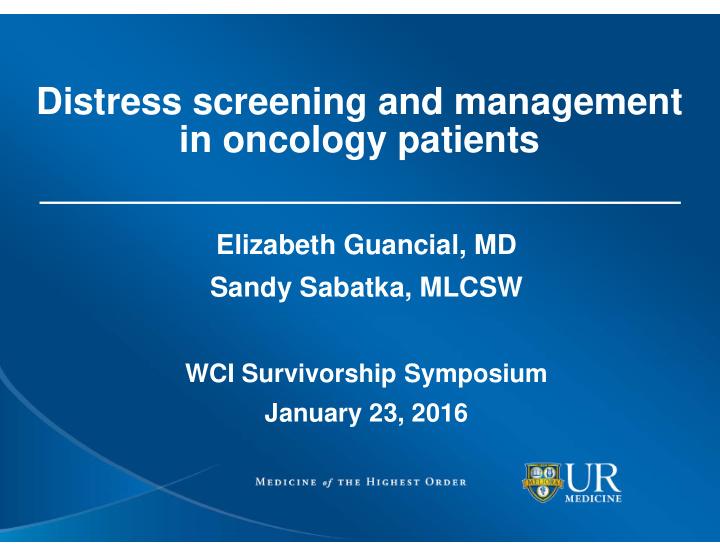



Distress screening and management in oncology patients Elizabeth Guancial, MD Sandy Sabatka, MLCSW WCI Survivorship Symposium January 23, 2016
Learning Objectives: 1. Define distress and how to assess for it. 2. Describe WCI rates of distress. 3. Highlight local resources for distress management in cancer survivors.
What is distress? “Multifactorial, unpleasant, emotional experience of psychological , social , and/or spiritual nature that may interfere with the ability to cope effectively with cancer , its symptoms , and treatment ” Holland et al. J Natl Comp Canc Netw. 2013.11: 190.
What is the goal of distress screening? Prospectively identify and triage cancer patients at risk for illness-related biopsychosocial complications that undermine the ability to benefit from medical care . Holland et al. J Natl Comp Canc Netw. 2013.11: 190.
Global implications of distress • Reduced HRQoL1 • Dissatisfaction with medical care2 • Cancer mortality3 Shim et al. Breast Cancer Res Treat. 2006; 99: 341. Pinquart and Duberstein. Psychol Med. 2010; 40: 1797. Von Essen et al. Eur J Cancer Care. 2002; 11: 91. Hamer et al. J. Psychosom. Res 2009; 66: 255.
Why now? • 1.6 million anticipated cancer diagnoses in US in 2016 • Distress identified in 30-40% of patients at some point during their course of oncology care • 70% cared for at centers accredited by the American College of Surgeons Commission on Cancer (WCI) American College of Surgeons. Cancer Program Standards 2012.
Our Vision The Wilmot Cancer Institute will be the leading regional cancer center and rank among the nation's premier comprehensive cancer centers by providing: o World-class research in the prevention, detection and treatment of cancers and their related conditions o Comprehensive and compassionate care, in a multidisciplinary approach, that is responsive to the needs of our patients and their families o Renowned teaching to ensure exceptional cancer care and research for future generations o Information and education to improve the health and welfare of our community o A dynamic and progressive atmosphere responsive to the needs of our patients and community
Value of distress screening Benefit to healthcare team: Benefit to patient: • Raises standard for clinical care • Gives them a voice/common language • Helps anticipate workload • De-stigmatizes request for help • Identifies patients at risk for disruption • Connection to resources of clinical services, “no show” • Improves continuity of care for • Streamlines triage and referral for psychosocial symptoms supportive care services
Value of distress screening • Generation of data to study: • Treatment compliance • Disease-related outcomes • Healthcare utilization/cost • Directly supports academic mission of excellence in education, research, patient care • Abstracts presented at Genitourinary American Society of Clinical Oncology meeting 2016 and Breast cancer symposium 2015
WCI Distress Management Advisory Committee • Founded in 2013 with goal of meeting new ACS standard of distress screening by 2015 • Committee composition • Participated in two NCI/City of Hope-sponsored workshops
DMAC Committee goals- Phase I : Select valid and reliable screening tool 1) Create resource list and plan to address psycho-social 2) needs Operationalize use and documentation in clinic workflow 3) Educate staff and patients (promote “buy-in”) 4) Coordinate system-wide implementation 5) Audit staff and provide ongoing re-education 6)
DMAC Committee goals- Phase II : Develop policies and procedures for use 1) Collect and analyze data 2) Support research and quality improvement projects through 3) creation of a Data Use Agreement Overseeing transition to electronic screening in WCC 4)
Screening tool for distress NCCN Distress Thermometer
Screening work flow
Distress Screen Score I nterpretation Red Zone Green Zone Yellow Zone Score 7-10 Score 0-3 Score of 4-6 • Patient in high distress • Considered mild • Warning signal • Response required • Patient is managing the • Response required • More thorough concern(s) well and has immediate assesment low distress For All Patients 1. Review screen and acknowledged score 2. Discuss with patient 3. Chart conversation 4. Follow through on action plan identified (ie. referral to Social Work, Palliative Care, Nutrition, Pain Clinic etc.)
Wilmot Cancer Institute Data 1506 patients screened (6/03/14-11/20/15) using NCCN DT tool 37.78% (569 of 1506 patients) scored a 4 or above
WCI Data Score # of Screens % of screens 4 or above 4 101 17% 5 146 26% 6 82 14% 7 89 16% 8 84 14% 9 23 4% 10 44 8%
Most Frequently Reported Problems on DT Psychosocial: Worry 41% overall most indicated of all categories Nervousness 35% Fears 24% Physical: Fatigue 39% Sleep 31% Pain 28%
WCI PROMIS pilot data • 275 completed by 129 individual patients (7/1-11/30/15) • 28% new patients (NP), 82% follow-ups (FP) • Median time to completion: 3.77 minutes Guancial. GU ASCO. 2016.
WCI PROMIS pilot data Guancial. GU ASCO. 2016.
Times of High Stress • Immediately after diagnosis • Waiting for appointments & results • 2-3 months after primary treatment Mild to Moderate Stress • 1-2 years after primary treatment • Prior to follow up appointments, scans & tests • Finding out someone else is diagnosed with cancer
Resources For Patients & Families • WCI Oncology Social Worker • WCI Support Groups • American Cancer Society (800) 227-2345 • Gilda’s Club Rochester (585) 423-9700 • Breast Cancer Coalition of Rochester (585) 473-8177 • Us Too Rochester, NY (585) 787-4011
Implementing Distress Screening Standard 3 .2 Psychosocial Distress Screening Com m ission on Cancer Program Standards 2 0 1 2 http: / / www.youtube.com/ watch?v= m5PE-i-0jOo
Recommend
More recommend